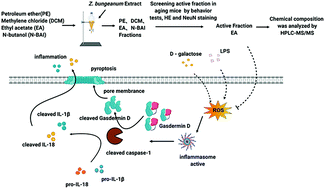Inhibition of NLRP3 inflammasome activation and pyroptosis with the ethyl acetate fraction of Bungeanum ameliorated cognitive dysfunction in aged mice
Abstract
Zanthoxylum bungeanum Maxim (Rutaceae), a medicinal herb and foodstuff, has previously been demonstrated as useful for the potential prevention of age-related cognitive dysfunction. However, the mechanisms and material basis remain elusively understood. The prevention of cognitive impairment by four fractions of Z. bungeanum was evaluated in D-galactose-induced aging mice, including petroleum ether (PE), methylene chloride (DCM), ethyl acetate (EA), and n-butanol (N-BAI). The results showed that mice treated with EA and N-BAI had significantly alleviated D-galactose-induced memory deficit. In addition, EA could clearly protect neurons from cell death, alleviate oxidative damage and inhibit the activation of microglia in aging mice. Our data also showed that the activation of the NLRP3 inflammasome, the expression of pyroptosis-related proteins, and the release of IL-1β and IL-18 could be remarkably inhibited by the EA fraction in aging mice and LPS/ATP-induced BV-2 microglial cells. Besides, the chemical composition of an active EA fraction was qualitatively analyzed by using HPLC-MS/MS. Thirty-four compounds were tentatively identified based on their retention times, accurate mass, and MS/MS spectra. Moreover, eighteen reference compounds were analyzed by HPLC-MS/MS and their contents of EA were determined. The work demonstrated that the ethyl acetate fraction of Bungeanum ameliorated cognitive deficits, and its effects may be related to ameliorating oxidative stress and suppressing the NLRP3 inflammasome pathway and GSDMD-mediated pyroptosis in aging mice.



 Please wait while we load your content...
Please wait while we load your content...